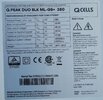I'm thinking about adding a third branch to my system. I would be doing most of the work myself, leaving final hookups for a licensed electrician. I'm looking at available microinverters and panels:
Then I notice that my existing professionally-installed system mates IQ-7+ microinverters with Q.PEAK DUO BLK ML-G9+380W panels, which have 6 × 22 monocrystalline Q.ANTUM solar half cells... 132 half-cells, equivalent to 66 full cells. Since the panels aren't 60 or 72 cells, they don't seem to be explicitly compatible with my IQ-7+ microinverters.
So the question is, what are the implications of this? Could I be getting 10% more output with properly matched micro-inverters? Are my micro-inverters ignoring 10% of the cells (rated 60 vs. 66 actual)? Would I see a difference if I upgraded my 66 cell panels to the IQ-7A, and pulled the IQ-7+ for my future branch with 60 cell panels?
I will note that my max actual production seems to be a brief 5.2 kW flat spot at high noon, where the system is rated 6.84 kW (18 x 380W panels, half facing SE, half facing SW). This seems suspiciously close to the IQ-7+ max continuous VA cap of 290 (... x 18 = 5.22 kW).
- Enphase IQ-7+, compatible with 60 & 72 cell PV modules, max continuous VA 290
- Enphase IQ-7A, compatible with 60, 66 & 72 cell PV modules, max continuous VA 335
Then I notice that my existing professionally-installed system mates IQ-7+ microinverters with Q.PEAK DUO BLK ML-G9+380W panels, which have 6 × 22 monocrystalline Q.ANTUM solar half cells... 132 half-cells, equivalent to 66 full cells. Since the panels aren't 60 or 72 cells, they don't seem to be explicitly compatible with my IQ-7+ microinverters.
So the question is, what are the implications of this? Could I be getting 10% more output with properly matched micro-inverters? Are my micro-inverters ignoring 10% of the cells (rated 60 vs. 66 actual)? Would I see a difference if I upgraded my 66 cell panels to the IQ-7A, and pulled the IQ-7+ for my future branch with 60 cell panels?
I will note that my max actual production seems to be a brief 5.2 kW flat spot at high noon, where the system is rated 6.84 kW (18 x 380W panels, half facing SE, half facing SW). This seems suspiciously close to the IQ-7+ max continuous VA cap of 290 (... x 18 = 5.22 kW).



